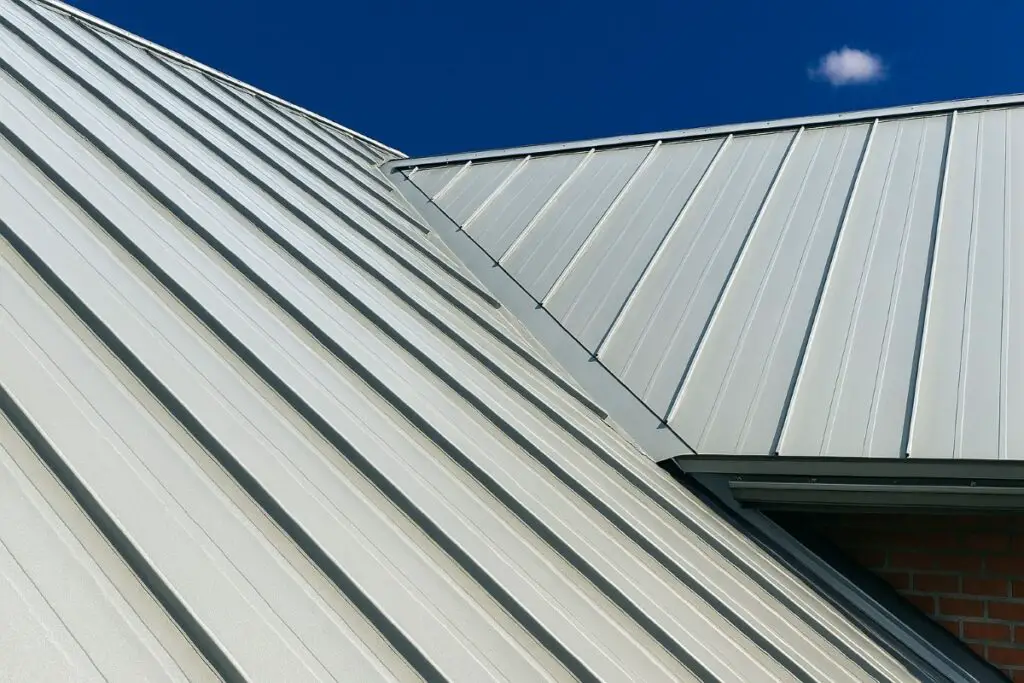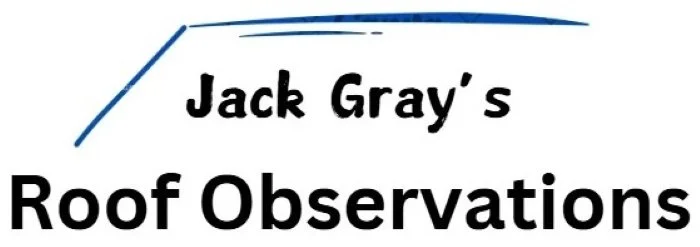Also see: Roof Cost Calculator
Table of Contents

Introduction
In this article, I’ll give you the typical costs for various types of metal roofs in 2025, including exposed fastener panels, standing seam panels, flat seam panels, and metal shingles. I’ll also explain the factors that determine metal roof costs.
Keep in mind that the cost of any particular metal roof will depend on several variables, including roof size, roof pitch, roof complexity, local labor rates, panel type, coating type, and the metal itself. Whether it’s steel, aluminum, copper, zinc, or stainless steel, market prices for the raw materials can significantly affect metal roofing material costs. Product quality also plays a big part as always. See my other article if you’re interested in my opinion as to who makes the best metal roofing products.
On average, the cost of a metal roof installation in 2025 ranges from $8.25 per square foot for basic exposed fastener steel panels to $42.00 per square foot for high-end installations like lead-coated copper panels with soldered flat seams. For an average 1,700-square-foot roof, that puts the total cost between $14,025 and $71,400, depending on the metal and roof type.
Also see my Roof Replacement Cost Guide, which has typical current roof prices for other residential and commercial roofing materials.
Note on Average Roof Size
A precise value for the average roof size for existing U.S. single-family homes is not directly available from any official source. I used publicly available data for average home square footage and the percentage of 1-story versus 2-story homes, as well as adjusting for typical eave overhangs and an estimated average roof pitch multiplier, to estimate an average U.S. roof size of a little under 1,700 square feet.
Things to Keep in Mind
These metal roof cost estimates should be fairly accurate; I make an effort to regularly update them using current material prices and labor data.
The costs listed below are national averages, and actual prices can vary significantly depending on your location. To get a better sense of what a new metal roof will cost in your area, see “Relative Construction Costs by U.S. State” and apply your local multiplier to the national average.
The cost estimates provided here assume installation on roofs with a 6/12 pitch or less and include all standard system components for each type of metal roof. Steeper pitches or more complex roof designs can increase labor costs by as much as 50%. Removing an existing roof typically adds $1 to $3 per square foot; these estimates include $2.00 per square foot for removing the old roof.
The prices shown assume the use of factory-finished metal panels or shingles of standard thickness and profile. Choosing heavier-gauge metal or a premium coating/finish can raise the total cost by 10 to 25 percent depending on the system.
Table: Metal Roof Cost per Square Foot by Material and System Type
| Average Cost of a Metal Roof | |||
|---|---|---|---|
| Metal Roofing Type | Average Installed Cost Per Square Foot |
Average Installed Cost Per Square (100 sq. ft.) |
Average Installed Cost Average Roof (1,700 sq. ft.) |
Main Metals Used in Roofing
Several different metals are commonly used in roofing, each with its own performance characteristics, appearance, and cost. The most widely used are:
- Steel: Galvanized or galvalume-coated steel is one of the most common roofing metals because it’s cheap, strong, and widely available. It’s used for exposed fastener panels, standing seam panels, and metal shingles. Premium coatings like PVDF (Kynar) can be applied to improve durability and fade resistance. See my Steel Roofing Cost Guide for more details.
- Aluminum: Lightweight and highly resistant to corrosion, aluminum is a good metal for coastal environments or areas with high humidity. It’s commonly used in both standing seam and metal shingle systems. While more expensive than steel, it typically lasts longer. See my Aluminum Roofing Cost Guide for more details.
- Copper: Known for its distinctive natural green patina, copper is one of the most durable roofing materials available. It’s often used on prestige institutional buildings and for high-end residential applications. Copper is the most expensive roofing metal and typically requires highly-skilled installers, especially for soldered seam systems. See my Copper Roof Cost Guide for more details.
- Zinc: Like copper, zinc develops a natural protective patina over time and is valued for its longevity and self-healing surface. It’s often used in standing seam applications. Zinc is more expensive than steel or aluminum but less costly than copper. Most zinc roofing is imported from Europe. See my Zinc Roof Cost Guide for more details.
- Stainless Steel: Highly corrosion-resistant and extremely durable, stainless steel is used in specialty applications where strength and appearance are both critical. It’s less common in residential construction due to its higher material cost.
These are the main metals used in metal roofing. Each of them can be used for different types of roof panels. For more detailed information on these metals and other metals used in metal roofing, see The 11 Types of Metals Used for Metal Roofing.
Types of Metal Roofs
Metal roofing is a broad category that includes any roofing system that uses sheet metal panels as the primary roof covering. Most metal roofs are installed over a solid deck with an underlayment, and are attached in a couple of different ways using screws, nails, and/or concealed clips, depending on the type of system. Metal roofing can be made from steel, aluminum, copper, zinc, or stainless steel, and may or may not have a protective coating, depending on the metal and the desired appearance.
Metal roofing systems, regardless of type, provide the benefits of durability, fire resistance, light weight, and relatively long service life. Most require very little maintenance and are available in a wide range of profiles, finishes, and colors. To get a better sense of how different systems look and perform, it’s worth browsing the websites of metal roofing manufacturers.
Standing Seam Metal Roofs
Standing seam metal roofs are very popular. These roofs are made up of panels that run vertically from ridge to eave, joined together with raised seams that keep water out and conceal the fasteners and clips. Because the panels are attached with clips or floating brackets, they can expand and contract freely with temperature changes, reducing stress and extending the life of the system. Panel widths typically range from 12 to 24 inches, depending on the design. Read more about standing seam roof costs.
Exposed Fastener Metal Panels
Exposed fastener panels, also known as screw-down or through-fastened metal roofing, are among the most affordable metal roofing systems. Long panels are fastened directly through the panels into the roof deck using gasketed screws. These fasteners remain visible after installation, giving the roof a more utilitarian look. Panel widths typically range from 24 to 36 inches, and lengths can exceed 20 feet. While relatively cheap, this system requires careful installation and maintenance to prevent leaks around the fasteners.
Metal Shingles
Metal shingles are smaller interlocking panels that can mimic the look of traditional shingles, slate, or wood shakes. Installed in overlapping courses, they use concealed fasteners and interlocking edges to secure the shingles and form a water-shedding surface. Metal shingles are especially well-suited to residential applications where aesthetics and longevity are both important.
Flat Seam Metal Roofs
True flat seam metal roofs (not simply “flat lock” panels) are constructed using square or rectangular panels joined edge-to-edge with seams that may be crimped, soldered, or sealed. This system is typically used on low-slope roof areas, curved roofs, and domes. Flat seam roofs require highly skilled installation and, in the case of soldered systems like copper, demand expert craftsmanship. This makes them one of the most expensive roof types due to high costs for both material and labor. Soldered flat seam roofs are also the only roofing system I know of that can be installed on pitches all the way down to 0%.
Metal Roof Cost Factors
As with any roof replacement job, the two largest cost components for a metal roofing installation are materials and labor. On average, total costs for a metal roof break down to roughly 50% materials and 50% labor, though the exact ratio depends on the roofing system, metal type, roof design, and location.
Material Costs
Material costs vary depending on several factors:
- Roof size
- Type of metal used (e.g. steel, aluminum, zinc, stainless steel, etc.)
- Panel or shingle type (e.g. standing seam, corrugated, flat seam, stamped shingles)
- Metal thickness or gauge (thicker metal sheet performs better but costs more)
- Coating or finish (e.g. SMP coatings, PVDF/Kynar, bare, painted, lead-coated, etc.)
- Accessories and trim (e.g. fasteners, flashings, ridge caps, eave trims, vents)
Higher-end metals, thicker gauges, and premium finishes can increase material costs by 10% to 30% or more.
Labor Costs
Labor costs for metal roofing vary significantly based on:
- Local wage rates and regional market conditions
- Installer qualifications (metal roofing requires specialized skill)
- Installation method (field-formed panels, exposed vs concealed fasteners, soldering)
Some systems, such as flat seam and standing seam, require highly trained crews and precise installation techniques; this increases labor costs compared to simpler systems like exposed fastener panels.
Roof Complexity
Roof complexity has a major impact on installation time and cost. Features such as:
- Skylights
- Chimneys
- Dormers
- Valleys and hips
- Curves, sweeps, or rising walls
…require careful measurement, custom flashing, and extra labor. Complicated roofs may take twice as long or more to complete than simple unobstructed gable roofs.
Roof Pitch
Steeper roofs over 6/12 pitch typically require additional safety precautions, harness systems, and sometimes scaffolding. This slows down the work, potentially increasing labor costs by 10% to 30% compared to walkable slopes.
Removal of Existing Roofing
Removing old roofing (and possibly deck repair) is typically necessary before installing metal panels or shingles. It is absolutely necessary if the existing roof has multiple existing roofing layers (this is a building code requirement), extensive damaged or uneven decking, or consists of a material like wood shake or concrete tile that is not an acceptable substrate for metal roofing. From the standpoint of future performance, removing the existing roof is almost always recommended before installing a metal roof.
A roof tear-off will add about $1.00 to $3.00 per square foot depending on the region, the roofing material, haul-off costs, and disposal fees.
Local Codes, Permits, and Restrictions
While most metal roofs meet standard building code requirements for fire resistance and durability, historic districts or HOAs may restrict the use of certain metal systems or finishes. Local building permits, inspection fees, and taxes will also add to the total project cost. Always check with your local building department before starting a project.

